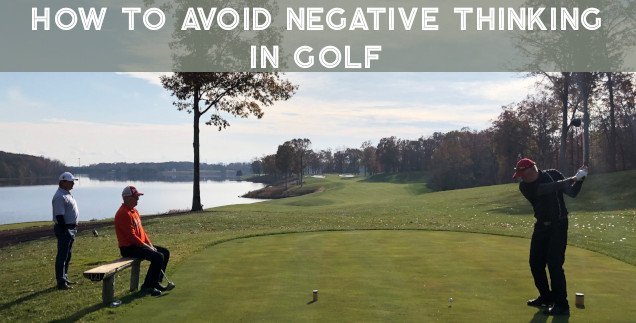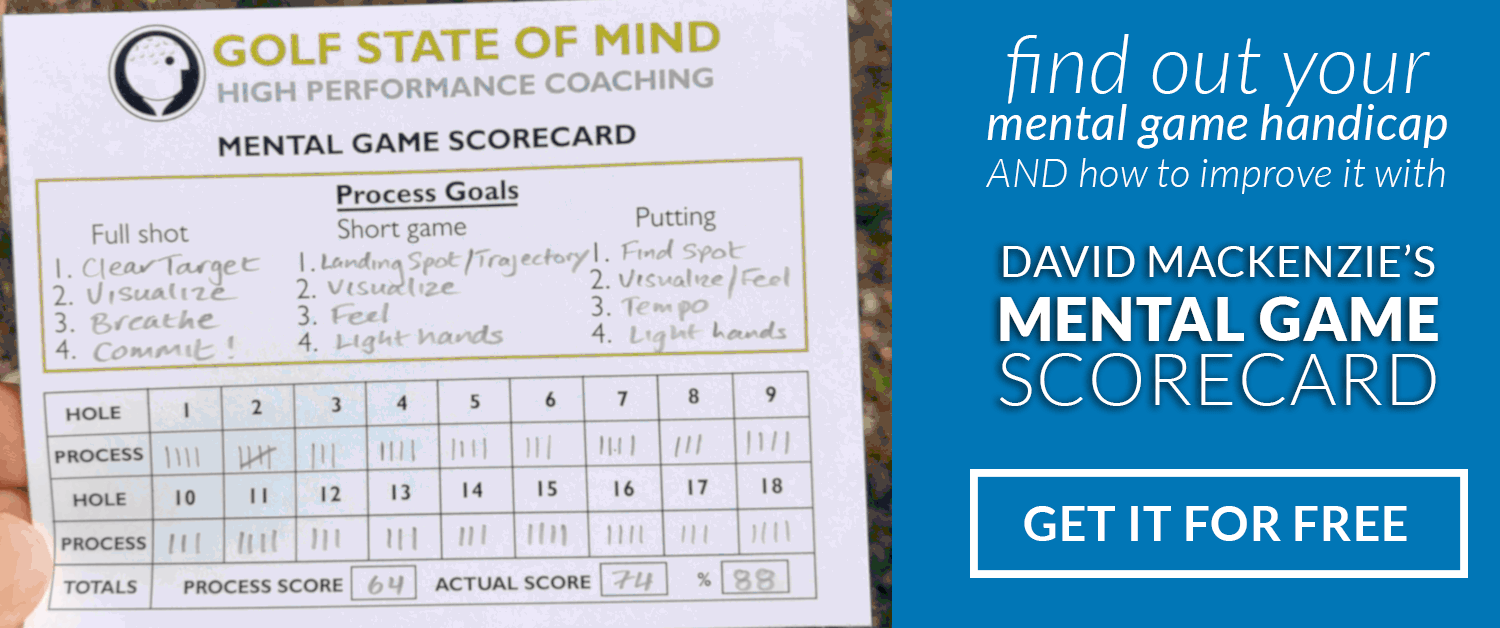
How To Avoid Negative Thinking In Golf
It’s easy to talk about the mental game of golf as being mental strategies that only apply to your golf game, but the reality is, how you live your life and deal with the challenges we face off the course, is directly correlated to how you perform on the course.
In most other sports, things happen faster – there’s less time to pay attention to our thoughts, so we are less affected by them. But in golf, most of the time you’re “playing”, you’re actually in between shots, with plenty of time to let your thoughts change the way you feel and how you play. Our minds can drift away to thoughts of winning the tournament, the mistake we just made, or blowing it and what people might think about us – all can lead to feelings of excitement, apprehension, anger, frustration etc, which are not helpful to playing good golf.
How To Reduce Negative Thinking In Golf
In this week’s lesson, I’d like to discuss one of the most powerful mental techniques that can be used to reduce negative thinking in golf, so you can play with less emotion, stress and tension. It will also help you off the course too.
You’ve probably heard of this mental technique before, but in this article I’d like to explore it further and show you how to practice it. If you can do so, it will help you deal with the thoughts, feelings and emotions which can hold us back from the freedom we need to be at our best.
The technique that I recommend that you implement into your game improvement plan, to give you more freedom from negative thinking in golf so you can access your best skills more often is called Mindfulness. So what is it and why will this help you?
The Wikipedia definition of “Mindfulness” is:
a mental state achieved by focusing one’s awareness on the present moment, while calmly acknowledging and accepting one’s feelings, thoughts, and bodily sensations, used as a therapeutic technique.
Basic Assumptions Of Mindfulness
One basic assumption of mindfulness is that we are not our thoughts – thoughts come and go and we don’t have any control over them. Everyone has an average of 70,000 thoughts that go through their stream of consciousness each day (they arrive and disappear) but most of them are just meaningless and fearful perceptions of the future. But if you allow them, they can start your survival instincts or “stress response” (tension, loss of focus, etc). However, when you become more Mindful, you realize that it’s not the thoughts themselves that are the problem, it’s how we react to them that can cause tension, stress and poor performance.
Giving Thoughts Power Turns Them Into Emotions and Feelings
If we allow ourselves to cling onto certain certain thoughts, we give them the power to become emotions and change the way we feel. The game of golf has so many variables and ups and downs, that if we let our thoughts take over, we get pulled onto an emotional roller coaster. For high performance, it’s imperative that we don’t let our minds control us in this way.
The good news, is with mindfulness practice, we can become more aware of where our attention is, and shift it away from those limiting thoughts that will negatively affect us.
What Is Mindfulness Practice?
Mindfulness is a way to change our relationship with our thoughts, so instead of accepting them as real, or “facts”, we develop the ability to simply watch them come and go. We can achieve this by developing a “greater awareness of our attention”. Without this awareness we are powerless to whatever thoughts happen to enter our consciousness.
With awareness, we can observe thoughts from a distance, and choose how we would like to respond to them (letting negative thinking in golf disappear), instead of giving them the power to become emotions, feelings and performance anxiety. When we can create freedom from our thoughts, we can (more easily) focus on what’s most important and access our best skills more freely.
Research on the effects of mindfulness on the brain are very compelling:
MRI scans show that after an eight-week course of mindfulness practice, the brain’s “fight or flight” center, the amygdala, appears to shrink. … The connection between the amygdala and the rest of the brain gets weaker, while the connections between areas associated with attention and concentration gets stronger (source: Scientific American)
How to practice becoming more mindful
Mindfulness is practiced through meditation. Meditation practice for as little as 10-20 mins per day can help you become more mindful of your attention and gain freedom from your thoughts and feelings.
Firstly, meditation is not what a lot of people think it is: It’s not a challenge to see how long you can go without thinking. Instead, meditation is about becoming more aware of where your mind is.
“Through the practice of meditation, we can seek to find a better connection with our body in the everyday moments that we often let pass us by, and create stronger awareness of how our emotions influence our behavior.” (West, 2016).
When you meditate, your mind will undoubtedly wander, but that’s OK. The practice is more about awareness and noticing that your mind is wandering, rather than trying to “quiet your mind”. The stillness in the mind comes from the awareness of what’s happening in the present moment, without judgement or resistance. When you notice your mind wandering, simply bring it back to your anchor, which could be your breathing, a mantra or other anchor depending on the type of meditation you are practicing. Notice your negative thoughts, but let them pass. Be accepting that you are not your thoughts and you don’t have to pay attention to them. As the title of Ryan Holiday’s new book tells us, “Stillness Is The Key”. The greater awareness, the better we can keep the mind still.
When you practice this, you’ll notice that you can become more immersed in your current experience, and the noise from thoughts that would normally distracted you (yes, they will always be there) will be quiet.
Negative Thoughts are OK
Most of us think that having negative thoughts is wrong. In fact, it could be said that thoughts are neither negative or positive, they are all neutral – it’s the attention to them that gives us positive or negative feelings. After all, thoughts are not real but they become energy in motion or “e-motion” when we give them power. We are all having similar thoughts in a round of golf, but the world’s best players do a better job of tuning them out, without resistance or telling themselves it’s wrong. In other words, negative thinking in golf can be avoided by simply having more acceptance of the negative thoughts you are having and just letting them go.
Let’s use the example of not being able to get a hazard out of your head before you play a shot. It’s not the thought about the hazard that causes the inevitable shot into the hazard, but the resistance to the thoughts about the hazard. Trying to tell yourself “don’t think of _____” only causes that very thing to be more clearly visible in your mind and more frustration and tension as a result.
A better approach is to be accepting of your distraction from the hazard and notice it without telling yourself it’s wrong. Simply bring yourself back to your anchor, which in the golfing context is the target. Too many golfers struggle with this and tell me “I just can’t get negative thoughts out of my head”. The greater the struggle with negative thinking in golf, the more prevalent they will be. It’s time to take a more mindful approach.
Be Mindful In The Post Shot Routine
However you feel after hitting a shot, is OK. It’s OK to feel disappointed or angry, and if you can acknowledge that, it will disappear quickly. Getting angry at yourself and beating yourself up for feeling that way, will allow that emotion to take hold and have a long-lasting effect on your performance. Instead, develop a consistent post shot routine, which will enable you to reset.
Make Mindfulness A Daily Exercise
Try to include meditation and mindfulness in your daily routine. It would be a good thing to start over the winter months and get your mind ready for the season starting in the spring. You won’t notice difference day to day, but over the course of weeks, you’ll find that you’ll notice negative thoughts, without it becoming negative thinking in golf – as a result, you’ll be much more present and calmer, with better access to your skills.


My thoughts have become my worst enemy on the golf course. I have gone from a 9 handicap to a 15. I struggle continuously throughout a match and beat myself up horribly when I hit a bad shot. Which is becoming more and more frequent. And now I believe it is invading everything I do.